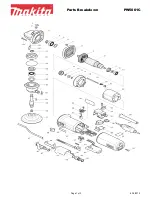
5
n
An extension cord should not be used unless
absolutely necessary.
Use of improper extension
cord could result in a risk of fire and electric shock. If
extension cord must be used, make sure:
a. That pins on plug of extension cord are the
same number, size and shape as those of
plug on charger.
b. That extension cord is properly wired and in
good electrical condition;
c. That wire size is large enough for AC ampere
rating of charger.
n
Do not operate charger with a damaged cord or plug,
which could cause shorting and electric shock. If dam-
aged, have the charger replaced by an authorised service
agent.
n
Do not operate charger if it has received a sharp blow,
been dropped or otherwise damaged in any way.
Take
it to an authorised service agent for electrical check to
determine if the charger is in good working order.
n
Do not disassemble charger.
Take it to an authorised
service agent when service or repair is required. Incorrect
reassembly may result in a risk of electric shock or fire.
n
Unplug charger from outlet before attempting
any maintenance or cleaning to reduce the risk of
electric shock.
n
Disconnect charger from the power supply when
not in use.
This will reduce the risk of electric shock or
damage to the charger if metal items should fall into the
opening. It also will help prevent damage to the charger
during a power surge.
n
Risk of electric shock.
Do not touch uninsulated portion
of output connector or uninsulated battery terminal.
n
Save these instructions.
Refer to them frequently
and use them to instruct others who may use this
tool. If you loan someone this tool, loan them these
instructions also to prevent misuse of the product and
possible injury.
n
The appliance is not intended for use by young chil-
dren or infirm persons without supervision.
n
Young children should be supervised to ensure that
they do not play with the appliance/charger.
SAFETY RULES FOR CHARGER
WARNING:
Some dust created by power sanding, sawing, grinding, drilling and other construction activities contains chemicals
known to cause cancer, birth defects or other reproductive harm. Some examples of these chemicals are:
• lead from lead-based paints
• crystalline silica from bricks and cement and other masonry products
• arsenic and chromium from chemically-treated lumber
Your risk from these exposures varies, depending on how often you do this type of work. To reduce your exposure to
these chemicals: work in a well ventilated area and work with approved safety equipment, such as those dust masks
that are specially designed to filter out microscopic particles.
WARNING!
READ AND UNDERSTAND ALL INSTRUCTIONS.
Failure to follow all instructions listed below, may result in
electric shock, fire and/or serious personal injury.
n
Before using battery charger,
read all instructions and
cautionary markings in this manual, on battery charger,
battery and product using battery to prevent misuse of
the products and possible injury or damage.
CAUTION:
To reduce the risk of electric shock or damage to
the charger and battery, charge only nickel-cadmium
rechargeable batteries as specifically designated on your
charger. Other types of batteries may burst, causing per-
sonal injury or damage.
n
Do not use charger outdoors or expose to wet or damp
conditions.
Water entering charger will increase the risk
of electric shock.
n
Use of an attachment not recommended or sold by the
battery charger manufacturer may result in a risk of
fire, electric shock or injury to persons.
Following this
rule will reduce the risk of electric shock, fire or serious
personal injury.
n
Do not abuse cord or charger.
Never use the cord to
carry the charger. Do not pull the charger cord rather than
the plug when disconnecting from receptacle. Damage
to the cord or charger could occur and create an electric
shock hazard. Replace damaged cords immediately.
n
Make sure cord is located so that it will not be stepped
on, tripped over, come in contact with sharp edges
or moving parts or otherwise subjected to damage or
stress.
This will reduce the risk of accidental falls, which
could cause injury and damage to the cord, which could
result in electric shock.
n
Keep cord and charger away from heat to prevent
damage to housing or internal parts.
n
Do not let gasoline, oils, petroleum-based products
etc. come in contact with plastic parts.
They contain
chemicals that can damage, weaken or destroy plastic.
Summary of Contents for CCC180L
Page 16: ...16...


































